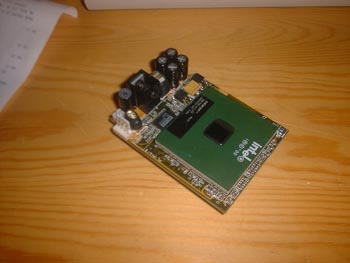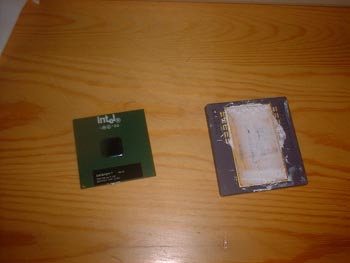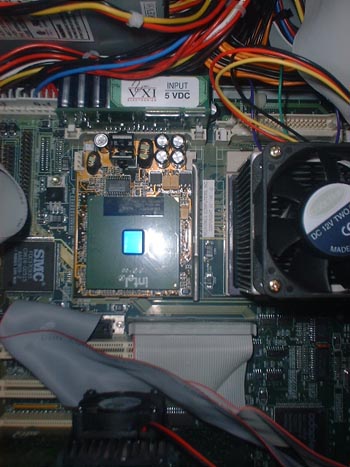Powerleap PL-ProII
Intel
P6 - A history lesson
Back
in the dark ages (1995) Intel introduced P6 architecture for the very high-end
market in the form of the Pentium pro processor. P6 has stayed its ground and
has only just been superseded with the introduction of the Pentium 4 (unless you
count the Athlon as post P6 - I'm not getting into that one) but unfortunately
the old Pentium Pro and its users have been left in a hole, created by the
following factors.
1)
The existing socket 7 systems had their level 2 memory cache on the motherboard.
Since the new P6 designs had on package (not on-die at this point) they required
a different connection, and socket 8 was born.
2)
Intel decided to create a P6 processor for the lower end market but the Pro was
far too expensive. Cut backs and changes had to be made. First of all the full
speed cache was expensive and made the chip run hot (hot enough to make an
overclocked Duron user cry!) so Intel went with 100MHz cache, then later on 1/2
CPU speed cache. A new physical layout was adopted and the processor and cache
where mounted on a PCB which then fitted into 'slot-1'. Slot 1 has now been
replaced by socket 370
The
only further development of socket 8 was the "Pentium 2 overdrive" a
P2 333 with full speed onboard cache for socket 8.
The
Pentium Pro's super high performance for a 1995-built chip is a mixed blessing.
I was running a Dual 200 system and until a few months ago and I didn't feel
much need (other than that ever existing NEED for more speed) for an upgrade,
but the time inevitably came when I started looking. Then I found out I'd been
preserved in a computing vacuum, everything was going to have to be replaced,
72-pin SIMMs just aren't used any more. The Pentium overdrive was far too
expensive (even second-hand). There are also many company servers still out
there with Pentium pro CPU's
Converting
socket mounted chips to slots can been done with ease. There have been socket 8
to slot 1 and socket 370 to slot 1 converters but, as you can imagine, mounting
a slotted chip onto a socket wasn't practical. So that leaves one feasible
option - Socket to Socket, and that's just what Powerleap have done.
Powerleap
are a specialist company for upgrading old systems; for instance they produce a
PPGA to FCPPGA converter (more later).
Due
to the 66MHz FSB of the celeron it is possible to use one on a socket 8
motherboard (a P3 could be used but a Pentium pro motherboard could not provide
the 100MHz-133MHz bus speeds), Powerleap have built a converter that provides
the correct voltages and pinout for a s370 CPU.
Compatibility
Powerleap
have a list of all compatible motherboards (http://www.powerleap.com/PL-ProII/compatibility.htm)
and say the following about other motherboards "The only real compatibility
issue so far is the problem with systems and motherboards that have a BIOS by
Award. Phoenix, AMI, and OEM BIOS's (such as IBM, Compaq, Gateway, Dell) are
fine."
The
Unit

It's
a tightly packed board that just needs a power supply (supplied as a split out
from a drive connector power cable). Due to the much larger size of socket 8
than socket 370, the whole thing has a footprint just larger then a pro chip,
meaning the possibility of conflicts with motherboard components is kept to a
minimum.

Fitting
it isn't much harder than fitting a new CPU, getting the heatsink clip on is a
bit of trouble once the unit's in the ZIF but it's only a case of a few minutes.
The one thing that did concern me was that the heatsink clip was going to touch
one of my VRM's - a bit of insulation tape sorted that one out.
The
old and new chips (pro still covered in the thermal paste) time for a pointless,
fact free, RANT. Just look at the 2 chips, a celeron 700 ready to go in and an
old pro 200 on its way out. No doubt witch has the speed.... but it's plastic,
plastic for god's sake. If you dropped one of those pro chips on someone's foot
it'd be a hospital job; leave a celeron in the wind and you might loose it. GER!
What is the world coming to? …. Rant Over.

The
new CPU fitted into the motherboard. You can make out the mighty alpha pep66
heatsink next door keeping the 2nd Pentium pro CPU cool.
SMP
I
went from a dual pro 200 system to a single Celeron 700 system. However it is
possible to upgrade an SMP system to 2 celeron 533's. The new FC-PPGA celerons (aka
celeron 2) are SMP disabled.
Performance
Well
at first it's quite simple to start with, it's a celeron. It has the RAW
performance of a celeron. I'm not going to go into the performance details of
the celeron since they'll be covered elsewhere. What I will discuss is how
running it on a Pentium pro motherboard alters the celerons performance.
However
it's not quite the same as owning a new celeron system. First of all you're
still going to be running 50-70ns RAM. Combined with the small cache size of the
celeron it can become quite a performance drain. However I find this an
acceptable loss for having such an easy upgrade.
The
second real problem is that of enabling the cache. Some Pentium pro
motherboards aren't able to start up the level 2 cache on the celeron chip so
software has to be used one the OS is loaded. My board (phoenix BIOS) was able
to load the level 2 cache but, in the interest of what it would be like to boot
without it, I disabled it in the BIOS. I'm afraid to say I can't give you a boot
time because, despite my wish to be thorough I couldn't be bothered to wait that
long. Suffice to say if I disable the cache whilst IN windows I watch each
window draw in about 5 seconds.
I
suppose if it was an application where a server was being upgraded the long boot
time wouldn't be an issue due to the long uptime of servers once initially
booted, so long as it didn't crash.
Price
A
bit of a down side, about US$300 for a 700MHz celeron 2. Despite recent drops in
price it still turns out you're paying about £100 more than for the chip on its
own. At this point you would have to consider the application for the upgrade
and whether the savings made in downtime or replacing expensive parts is worth
it.
Documentation
The
only huge downfall of the package - the manual is contradictory and out of date.
It neglects to mention the new Celeron 2 issues (like needing a neo370 PPGA to
FC-PPGA adapter) and the celeron 2 supplement actually contains a photograph of
a celeron 2 installation that would not work (again needing the flip-chip
adapter). Fortunately the upgrade isn't hard and it's easy enough to go by
pictures
The
Verdict
It
does what it says, upgrade a Pentium pro system to a Celeron system. The extra
cost, as I mentioned before, would have to be justified if you either have a lot
of other equipment that would need to be replaced (like 512Mb of EDO or such
like) or you needed a quick upgrade of a mission critical system. If you do
decide a CPU upgrade is the way forward, this one can't be beaten.













